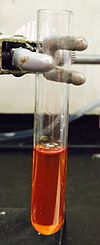
| |

| |

| |
| Names | |
|---|---|
| IUPAC name
Pentacarbonyliron(0)
| |
| Other names
Pentacarbonyl iron
Iron carbonyl | |
| Identifiers | |
3D model (JSmol)
|
|
| ChEBI | |
| ChemSpider | |
| ECHA InfoCard | 100.033.323 |
PubChem CID
|
|
| RTECS number |
|
| UNII | |
| UN number | 1994 |
CompTox Dashboard (EPA)
|
|
| |
| |
| Properties | |
| Fe(CO)5 | |
| Molar mass | 195.90 g/mol |
| Appearance | straw-yellow to brilliant orange liquid |
| Odor | musty |
| Density | 1.453 g/cm3 |
| Melting point | −21.0 °C (−5.8 °F; 252.2 K) |
| Boiling point | 103 °C (217 °F; 376 K) |
| Insoluble | |
| Solubility | Soluble in organic solvents slightly soluble in alcohol insoluble in ammonia |
| Vapor pressure | 40 mmHg (30.6 °C)[1] |
Refractive index (nD)
|
1.5196 (20 °C) |
| Structure | |
| D3h | |
| trigonal bipyramidal | |
| trigonal bipyramidal | |
| 0 D | |
| Hazards | |
| Occupational safety and health (OHS/OSH): | |
Main hazards
|
Very toxic, highly flammable |
| GHS labelling: | |
  
| |
| NFPA 704 (fire diamond) | |
| Flash point | −15 °C (5 °F; 258 K) |
| 49 °C (120 °F; 322 K) | |
| Explosive limits | 3.7–12.5% |
| Lethal dose or concentration (LD, LC): | |
LD50 (median dose)
|
25 mg/kg (rat, oral) |
| NIOSH (US health exposure limits): | |
PEL (Permissible)
|
none[1] |
REL (Recommended)
|
TWA 0.1 ppm (0.23 mg/m3) ST 0.2 ppm (0.45 mg/m3)[1] |
IDLH (Immediate danger)
|
0.4 ppm[1] |
| Safety data sheet (SDS) | ICSC 0168 |
| Related compounds | |
Related compounds
|
|
Except where otherwise noted, data are given for materials in their standard state (at 25 °C [77 °F], 100 kPa).
| |
Iron pentacarbonyl, also known as iron carbonyl, is the compound with formula Fe(CO)5. Under standard conditions Fe(CO)5 is a free-flowing, straw-colored liquid with a pungent odour. Older samples appear darker. This compound is a common precursor to diverse iron compounds, including many that are useful in small scale organic synthesis.[2]
- ^ a b c d NIOSH Pocket Guide to Chemical Hazards. "#0345". National Institute for Occupational Safety and Health (NIOSH).
- ^ Samson, S.; Stephenson, G. R. (2004). "Pentacarbonyliron". In Paquette, L. (ed.). Encyclopedia of Reagents for Organic Synthesis. New York, NY: J. Wiley & Sons. doi:10.1002/047084289X. hdl:10261/236866. ISBN 9780471936237.
